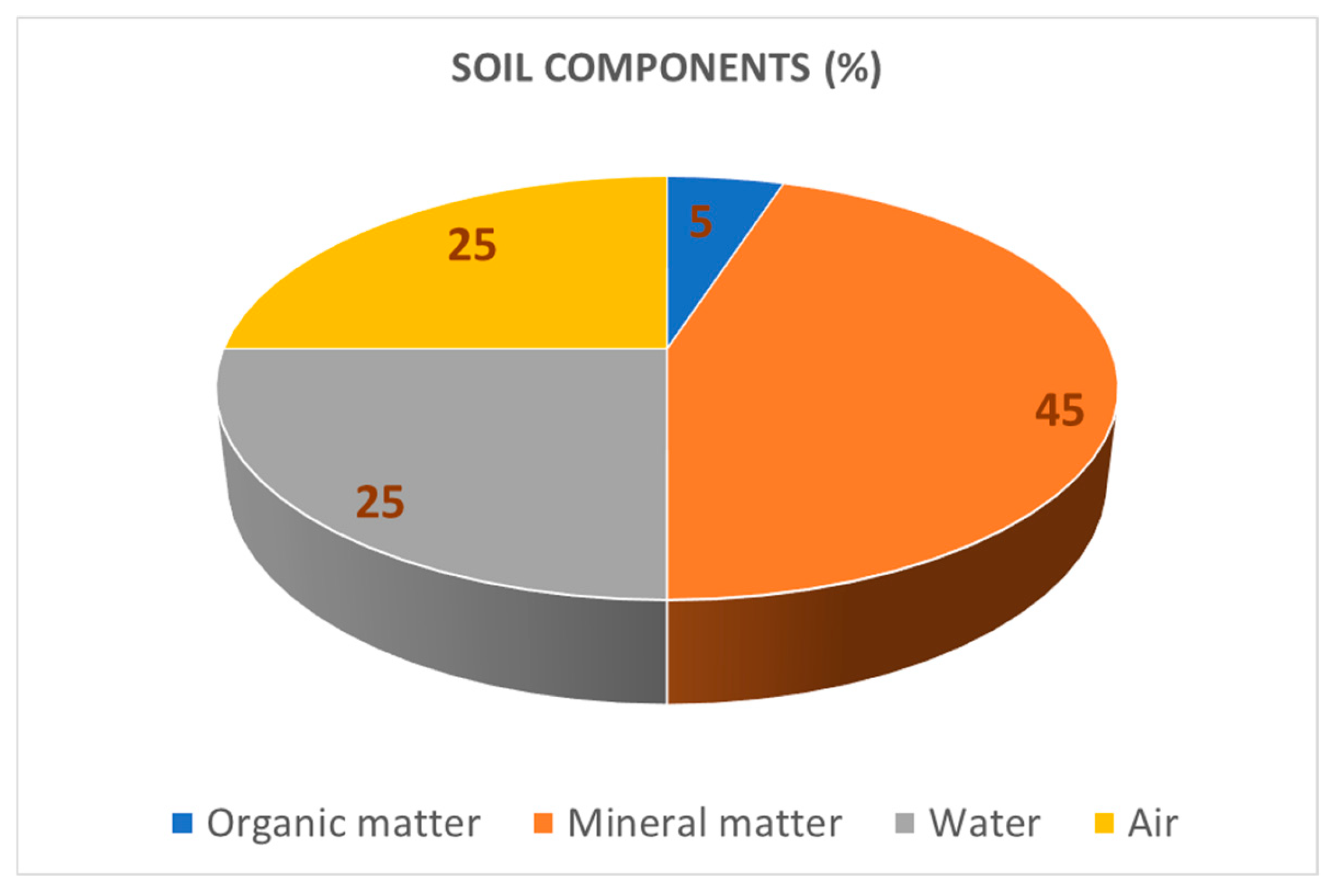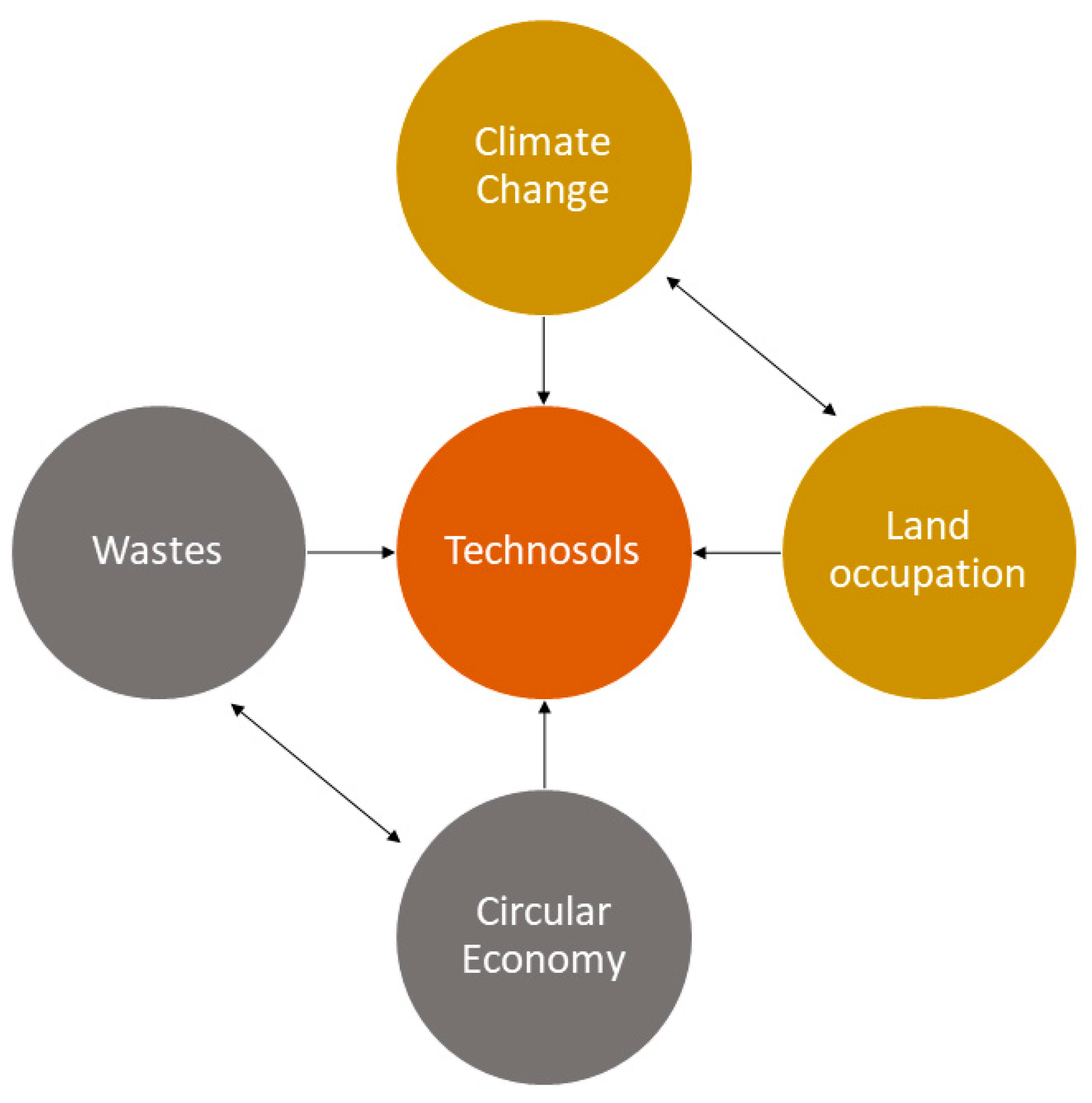Constructing Soils to Mitigate Land Occupation by Urban Expansion and Metabolism to Improve Healthy Cities
Abstract
:1. Introduction
2. What Is a Technosol?
3. Making Technosols
4. Technosols, Wastes and Policy Makers
5. Technosol Functions for Healthy Cities
- provide food and biomass production, including in agriculture and forestry [55];
- absorb, store and filter water and transform nutrients and substances, thus protecting groundwater bodies [56];
- provide the basis for life and biodiversity, including habitats, species and genes;
- provide a physical platform and cultural services for humans and their activities [59];
- act as a source of raw materials [33];
- constitute an archive of geological, geomorphological and archaeological heritage [60].
6. Technosol and Ecosystem Services
7. Conclusions
Author Contributions
Funding
Data Availability Statement
Conflicts of Interest
References
- World Bank. Urban Development. Last Updated: 3 April 2023. 2023. Available online: https://www.worldbank.org/en/topic/urbandevelopment (accessed on 19 June 2024).
- Scalancghe, R.; Marsan, F.A. The anthropogenic sealing of soils in urban areas. Landsc. Urban Plan. 2008, 90, 1–10. [Google Scholar] [CrossRef]
- Rodríguez-Espinosa, T.; Navarro-Pedreño, J.; Gómez Lucas, I.; Almendro-Candel, M.B. Land recycling, food security and technosols. J. Geogr. Res. 2021, 4, 44–50. [Google Scholar] [CrossRef]
- Nickayin, S.S.; Perrone, F.; Ermini, B.; Quaranta, G.; Salvia, R.; Gambella, F.; Egidi, G. Soil Quality and Peri-Urban Expansion of Cities: A Mediterranean Experience (Athens, Greece). Sustainability 2021, 13, 2042. [Google Scholar] [CrossRef]
- Phillips, M. Dense, more compact cities help combat climate change, inequality. Urban Land Magazine. 8 February 2016. Available online: https://urbanland.uli.org/planning-design/dense-compact-cities-help-combat-climate-change-inequality (accessed on 19 June 2024).
- Derrible, S.; Cheah, L.; Arora, M.; Yeow, L.W. Urban Metabolism. In Urban Informatics; The Urban Book Series; Shi, W., Goodchild, M.F., Batty, M., Kwan, M.P., Zhang, A., Eds.; Springer: Singapore, 2021; pp. 85–114. [Google Scholar] [CrossRef]
- Zhang, Y.; Yang, Z.; Yu, X. Urban Metabolism: A Review of Current Knowledge and Directions for Future Study. Environ. Sci. Technol. 2015, 49, 11247–11263. [Google Scholar] [CrossRef] [PubMed]
- Swilling, M.; Hajer, M.; Baynes, T.; Bergesen, J.; Labbé, F.; Musango, J.K.; Ramaswami, A.; Robinson, B.; Salat, S.; Suh, S.; et al. The Weight of Cities: Resource Requirements of Future Urbanization. A Report by the International Resource Panel; United Nations Environment Programme: Nairobi, Kenya, 2018. Available online: https://www.resourcepanel.org/reports/weight-cities (accessed on 19 June 2024).
- Pincetl, S.; Bunje, P.; Holmes, T. An expanded urban metabolism method: Towards a systems approach for assessing the urban energy processes and causes. Landsc. Urban Plan. 2012, 107, 193–202. [Google Scholar] [CrossRef]
- UN-HABITAT. Urban Energy. Available online: https://unhabitat.org/topic/urban-energy (accessed on 19 June 2024).
- de Sa, T.H.; Mwaura, A.; Vert, C.; Mudu, P.; Roebbel, N.; Tran, N.; Neira, M. Urban design is key to healthy environments for all. Lancet Glob. Health 2022, 10, e786–e787. [Google Scholar] [CrossRef]
- Navarro-Pedreño, J. Mitigation of climate change: Too little or too much. J. Geogr. Res. 2022, 5, 55–56. [Google Scholar] [CrossRef]
- Duguma, L.A.; Minang, P.A.; van Noordwijk, M. Climate Change Mitigation and Adaptation in the Land Use Sector: From Complementarity to Synergy. Environ. Manag. 2014, 54, 420–432. [Google Scholar] [CrossRef]
- European Environment Agency. Assessing the Costs and Benefits of Climate Change Adaptation. 2023. Available online: https://www.eea.europa.eu/publications/assesing-the-costs-and-benefits-of (accessed on 21 June 2024).
- Bolund, P.; Hunhammar, S. Ecosystem services in urban areas. Ecol. Econ. 1999, 29, 293–301. [Google Scholar] [CrossRef]
- Blanchart, A.; Consalès, J.N.; Séré, G.; Schwartz, C. Consideration of soil in urban planning documents—A French case study. J. Soils Sediments 2019, 19, 3235–3244. [Google Scholar] [CrossRef]
- Mishra, U.; Torn, M.S.; Masanet, E.; Ogle, S.M. Improving regional soil carbon inventories: Combining the IPCC carbon inventory method with regression kriging. Geoderma 2012, 189–190, 288–295. [Google Scholar] [CrossRef]
- Navarro-Pedreño, J.; Almendro-Candel, M.B.; Zorpas, A.A. The Increase of Soil Organic Matter Reduces Global Warming, Myth or Reality? Science 2021, 3, 18. [Google Scholar] [CrossRef]
- Daily, G.C. Nature’s Services: Societal Dependence on Natural Ecosystems; Inland Press: Washington, DC, USA, 1997; p. 392. [Google Scholar]
- Alcano, J.; Ash, N.J.; Butler, C.D.; Callicot, J.B.; Capistrano, D.; Carpenter, S.R.; Castilla, J.C.; Cambers, R.; Chopra, K.; Cropper, A.; et al. Ecosystems and Human Well-Being: A Framework for Assessment/Millennium Ecosystem Assessment; Inland Press: Washington, DC, USA, 2003; p. 245. [Google Scholar]
- Adhikari, K.; Hartemink, A.E. Linking soils to ecosystem services—A global review. Geoderma 2016, 262, 101–111. [Google Scholar] [CrossRef]
- Hernández-Soriano, M.C.; Junod, M.F. Soil: The foundation of life on Earth. The John Innes Centre Magazine Advances. 2020. Issue 32 (winter 2019–2020). Available online: https://www.jic.ac.uk/advances/soil-the-foundation-of-life-on-earth/#:~:text=In%20optimum%20conditions%20and%20a,in%20a%20mere%20200%20years (accessed on 23 June 2024).
- Gill, E.E.; Handley, J.F.; Ennos, A.R.; Pauleit, S. Adapting cities for climate change: The role of the green infrastructure. Built Environ. 2007, 33, 115–133. [Google Scholar] [CrossRef]
- Brussels, 17.11.2021 COM(2021) 699 Final Communication from the Commission to the European Parliament, the Council, the European Economic and Social Committee and the Committee of the Regions EU Soil Strategy for 2030. Reaping the Benefits of Healthy Soils for People, Food, Nature and Climate {SWD(2021) 323 Final}. Available online: https://environment.ec.europa.eu/publications/eu-soil-strategy-2030_en (accessed on 25 June 2024).
- Puig de la Bellacasa, M. Making time for soil: Technoscientific futurity and the pace of care. Soc. Stud. Sci. 2015, 45, 691–716. [Google Scholar] [CrossRef] [PubMed]
- IUSS Working Group WRB. World reference base for soil resources 2014. In International Soil Classification System for Naming Soils and Creating Legends for Soil Maps, World Soil Resources Reports; FAO, Working Group WRB: Rome, Italy, 2014; Volume 106. [Google Scholar]
- IUSS Working Group WRB. World Reference Base for Soil Resources. In International Soil Classification System for Naming Soils and Creating Legends for Soil Maps, 4th ed.; International Union of Soil Sciences (IUSS): Vienna, Austria, 2022; p. 236. [Google Scholar]
- Galbraith, J.M. Soil Order Proposal–HAHT Soils (Artesols); 22nd Draft; USDA: Washington, DC, USA, 23 May 2022. Available online: https://www.nrcs.usda.gov/sites/default/files/2023-01/Artesols-Order-Proposal.docx (accessed on 25 June 2024).
- Leguédois, S.; Séré, G.; Auclerc, A.; Cortet, J.; Huot, H.; Ouvrard, S.; Watteau, F.; Schwartz, C.; Morel, J.L. Modelling pedogenesis of Technosols. Geoderma 2016, 262, 199–212. [Google Scholar] [CrossRef]
- Séré, G.; Schwartz, C.; Ouvrard, S.; Renat, J.-C.; Watteau, F.; Villemin, G.; Morel, J.L. Early pedogenic evolution of constructed Technosols. J. Soils Sediments 2010, 10, 1246–1254. [Google Scholar] [CrossRef]
- Kalev, S.D.; Toor, G.S. The Composition of Soils and Sediments. In Green Chemistry; Török, B., Dransfield, T., Eds.; Elsevier: Amsterdam, The Netherlands, 2018; pp. 339–357. [Google Scholar] [CrossRef]
- Lal, R. Restoring Soil Quality to Mitigate Soil Degradation. Sustainability 2015, 7, 5875–5895. [Google Scholar] [CrossRef]
- Firpo, B.A.; Weiler, J.; Schneider, I.A.H. Technosol made from coal waste as a strategy to plant growth and environmental control. Energy Geosci. 2021, 2, 160–166. [Google Scholar] [CrossRef]
- Gonçalves, J.O.; Fruto, C.M.; Barranco, M.J.; Oliveira, M.L.S.; Ramos, C.G. Recovery of Degraded Areas through Technosols and Mineral Nanoparticles: A Review. Sustainability 2022, 14, 993. [Google Scholar] [CrossRef]
- Séré, G.; Schwartz, C.; Ouvrard, S.; Sauvage, C.; Renat, J.-C.; Morel, J.L. Soil construction: A step for ecological reclamation of derelict lands. J. Soils Sediments 2008, 8, 130–136. [Google Scholar] [CrossRef]
- Cornell University, Cooperation Extension. Soil texture. Agron. Fact Sheet Ser. 2007, 29, 1–2. Available online: http://nmsp.cals.cornell.edu/publications/factsheets/factsheet29.pdf (accessed on 3 July 2024).
- Kumar, D.; Purakayastha, T.J.; Das, R.; Yadav, R.K.; Shivay, Y.S.; Jha, P.K.; Singh, S.; Aditi, K.; Prasad, P.V.V. Long-Term Effects of Organic Amendments on Carbon Stability in Clay–Organic Complex and Its Role in Soil Aggregation. Agronomy 2023, 13, 39. [Google Scholar] [CrossRef]
- Shkaruba, A.; Skryhan, H.; Likhacheva, O.; Katona, A.; Maryskevych, O.; Kireyeu, V.; Sepp, K.; Shpakivska, I. Development of sustainable urban drainage systems in Eastern Europe: An analytical overview of the constraints and enabling conditions. J. Environ. Plan. Manag. 2021, 64, 2435–2458. [Google Scholar] [CrossRef]
- Rodríguez-Espinosa, T.; Navarro-Pedreño, J.; Gómez-Lucas, I.; Jordán-Vidal, M.M.; Bech-Borras, J.; Zorpas, A.A. Urban areas, human health and technosols for the green deal. Environ. Geochem. Health 2021, 43, 5065–5086. [Google Scholar] [CrossRef]
- Fabbri, D.; Pizzol, R.; Calza, P.; Malandrino, M.; Gaggero, E.; Padoan, E.; Ajmone-Marsan, F. Constructed Technosols: A Strategy toward a Circular Economy. Appl. Sci. 2021, 11, 3432. [Google Scholar] [CrossRef]
- Watkins, E.; Meysner, A. European Circular Economy Policy Landscape Overview; Institute for European Environmental Policy: Brussels, Belgium, 2022; p. 87. Available online: https://ieep.eu/wp-content/uploads/2022/11/European-Circular-Economy-policy-landscape-overview.pdf (accessed on 23 June 2024).
- EU. ZeroWasteCities. Available online: https://zerowastecities.eu/ (accessed on 3 July 2024).
- Azevedo-Lopes, T.; Melo Queiroz, H.; Ruiz, F.; Asensio, V.; Duim Ferreira, A.; Cherubin, M.R.; Osório Ferreira, T. From waste to soil: Technosols made with construction and demolition waste as a nature-based solution for land reclamation. Waste Manag. 2024, 186, 153–165. [Google Scholar] [CrossRef] [PubMed]
- Rokia, S.; Séré, G.; Schwartz, C.; Deeb, M.; Fournier, F.; Nehls, T.; Damas, O.; Vidal-Beaudet, L. Modelling agronomic properties of Technosols constructed with urban wastes. Waste Manag. 2014, 34, 2155–2162. [Google Scholar] [CrossRef]
- Kharytonov, M.; Martynova, N.; Babenko, M.; Rula, I.; Ungureanu, N.; Ștefan, V. Production of Sweet Sorghum Bio-Feedstock on Technosol Using Municipal Sewage Sludge Treated with Flocculant, in Ukraine. Agriculture 2023, 13, 1129. [Google Scholar] [CrossRef]
- Grard, B.J.; Manouchehri, N.; Aubry, C.; Frascaria-Lacoste, N.; Chenu, C. Potential of Technosols Created with Urban By-Products for Rooftop Edible Production. Int. J. Environ. Res. Public Health 2020, 5, 3210. [Google Scholar] [CrossRef]
- WHO. Health Promotion Glossary; WHO/HPR/HEP/98.1; World Health Organization: Geneva, Switzerland, 1998; Available online: https://www.who.int/publications/i/item/WHO-HPR-HEP-98.1 (accessed on 14 July 2024).
- Séré, G.; Le Guern, C.; Bispo, A.; Layet, C.; Ducommun, C.; Clesse, M.; Schwartz, C.; Vidal-Beaudet, L. Selection of soil health indicators for modelling soil functions to promote smart urban planning. Sci. Total Environ. 2024, 924, 171347. [Google Scholar] [CrossRef]
- Salomon, M.J.; Watts-Williams, S.J.; McLaughlin, M.J.; Cavagnaro, T.R. Urban soil health: A city-wide survey of chemical and biological properties of urban agriculture soils. J. Clean. Prod. 2020, 275, 122900. [Google Scholar] [CrossRef]
- Schindelbeck, R.R.; van Es, H.M.; Abawi, G.S.; Wolfe, D.W.; Whitlow, T.L.; Gugino, B.K.; Idowu, O.J.; Moebius-Clune, B.N. Comprehensive assessment of soil quality for landscape and urban management. Landsc. Urban Plan. 2008, 88, 73–80. [Google Scholar] [CrossRef]
- Zambon, I.; Serra, P.; Salvati, L. The (Evolving) urban footprint under sequential building cycles and changing socio-demographic contexts. Environ. Impact Assess. Rev. 2019, 75, 27–36. [Google Scholar] [CrossRef]
- EC. Caring for Soil Is Caring for Life. Ensure 75% of Soils Are Healthy by 2030 for Food, People, Nature and Climate. Report of the Mission Board for Soil Health and Food 2020, Brussels. 2020. Available online: https://op.europa.eu/en/publication-detail/-/publication/4ebd2586-fc85-11ea-b44f-01aa75ed71a1/ (accessed on 19 July 2024).
- EEA. Indicator Assessment Progress in Management of Contaminated Sites; European Environment Agency: Copenhagen, Denmark, 2019; Available online: https://www.eea.europa.eu/data-and-maps/indicators/progress-in-management-of-contaminated-sites-3/assessment (accessed on 19 July 2024).
- Sajjad, M.; Huang, Q.; Khan, S.; Khan, M.A.; Liu, Y.; Wang, J.; Lian, F.; Wang, Q.; Guo, G. Microplastics in the soil environment: A critical review. Environ. Technol. Innov. 2022, 27, 102408. [Google Scholar] [CrossRef]
- Prado, B.; Mora, L.; Abbruzzini, T.; Flores, S.; Cram, S.; Ortega, P.; Navarrete, A.; Siebe, C. 2020, Feasibility of urban waste for constructing Technosols for plant growth. Rev. Mex. Cienc. Geol. 2020, 37, 237–249. [Google Scholar] [CrossRef]
- Bilibio, C.; Retz, S.; Schellert, C.; Hensel, O. Drainage properties of technosols made of municipal solid waste incineration bottom ash and coal combustion residues on potash-tailings piles: A lysimeter study. J. Clean. Prod. 2021, 279, 123442. [Google Scholar] [CrossRef]
- Gardi, C.; Jeffery, S. Soil Biodiversity; Office for Official Publications of the European Communities© European Communities: Luxembourg, 2009; p. 27. [Google Scholar] [CrossRef]
- Allory, V.; Séré, G.; Ouvrard, S. A meta-analysis of carbon content and stocks in Technosols and identification of the main governing factors. Eur. J. Soil Sci. 2022, 7381, e13141. [Google Scholar] [CrossRef]
- González-Méndez, B.; Chávez-García, E. Re-thinking the Technosol design for greenery systems: Challenges for the provision of ecosystem services in semiarid and arid cities. J. Arid Environ. 2020, 179, 104191. [Google Scholar] [CrossRef]
- Huot, H.; Faure, P.; Biache, C.; Lorgeoux, C.; Simonnot, M.O.; Morel, J.L. A Technosol as archives of organic matter related to past industrial activities. Sci. Total Environ. 2014, 487, 389–398. [Google Scholar] [CrossRef]
- Lehmann, J.; Bossio, D.A.; Kögel-Knabner, I.; Rillig, M.C. The concept and future prospects of soil health. Nature reviews. Earth Environ. 2020, 1, 544–553. [Google Scholar] [CrossRef]
- Zhao, Z.; Liu, C.; Yan, M.; Pan, G. Understanding and enhancing soil conservation of water and life. Soil Sci. Environ. 2023, 2, 9. [Google Scholar] [CrossRef]
- COWI; Ecologic Institute; IEEP. Manual de Orientación Técnica: Creación y Aplicación de Mecanismos de Captura de Dióxido de Carbono en Suelos Agrícolas Basados en Resultados en la UE Informe a la Comisión Europea. DG Acción Por el Clima 2021, en el Marco del Contrato n.º CLIMA/C.3/ETU/2018/007. COWI, Kongens Lyngby. Available online: https://op.europa.eu/es/publication-detail/-/publication/b7b20495-a73e-11eb-9585-01aa75ed71a1/language-es/format-PDF/source-335776661 (accessed on 6 July 2024).
- Shen, Q.; Pan, G. Inaugural editorial: Soil Science and Environment. Soil Sci. Environ. 2022, 1, 1. [Google Scholar] [CrossRef]
- Schindler, D.; Bauhus, J.; Mayer, H. Wind effects on trees. Eur. J. For. Res. 2012, 131, 159–163. [Google Scholar] [CrossRef]
- Gardiner, B. Wind damage to forests and trees: A review with an emphasis on planted and managed forests. J. For. Res. 2021, 26, 248–266. [Google Scholar] [CrossRef]
- Azimi, S.; Rocher, V.; Muller, M.; Moilleron, R.; Thevenot, D.R. Sources, distribution and variability of hydrocarbons and metals in atmospheric deposition in an urban area (Paris, France). Sci. Total Environ. 2005, 337, 223–239. [Google Scholar] [CrossRef]
- Derissen, S.; Latacz-Lohmann, U. What are PES? A review of definitions and an extension. Ecosyst. Serv. 2013, 6, 12–15. [Google Scholar] [CrossRef]
- Gao, F.; Xin, X.; Song, J.; Li, X.; Zhang, L.; Zhang, Y.; Liu, J. Simulation of LUCC Dynamics and Estimation of Carbon Stock under Different SSP-RCP Scenarios in Heilongjiang Province. Land 2023, 12, 1665. [Google Scholar] [CrossRef]
- Ge, J.; Lin, B. Convergence or divergence? Unraveling the global development pattern of forest carbon sink. Environ. Impact Assess. Rev. 2024, 105, 107442. [Google Scholar] [CrossRef]
- Mo, L.; Zohner, C.M.; Reich, P.B.; Liang, J.; De Miguel, S.; Nabuurs, G.J.; Renner, S.S.; van den Hoogen, J.; Araza, A.; Herold, M.; et al. Integrated global assessment of the natural forest carbon potential. Nature 2023, 624, 92–101. [Google Scholar] [CrossRef]
- Lv, T.; Geng, C.; Zhang, X.; Li, Z.; Hu, H.; Fu, S. Impact of the intensive use of urban construction land on carbon emission efficiency: Evidence from the urban agglomeration in the middle reaches of the Yangtze River. Environ. Sci. Pollut. Res. Int. 2023, 30, 113729–113746. [Google Scholar] [CrossRef] [PubMed]
- van der Werf, G.; Morton, D.; DeFries, R.; Olivier, J.G.J.; Kasibhatla, P.S.; Jackson, R.B.; Collatz, G.J.; Randerson, J.T. CO2 emissions from forest loss. Nat. Geosci. 2009, 2, 737–738. [Google Scholar] [CrossRef]
- Deeb, M.; Groffman, P.; Joyner, J.L.; Lozefski, G.; Paltseva, A.; Lin, B.; Mania, K.; Cao, D.L.; McLaughlin, J.; Muth, T.; et al. Soil and microbial properties of green infrastructure stormwater management system. Ecol. Eng. 2018, 125, 68–75. [Google Scholar] [CrossRef]
- Deeb, M.; Groffman, P.M.; Blouin, M.; Egendorf, S.P.; Vergnes, A.; Vasenev, V.; Cao, D.L.; Walsh, D.; Morin, T.; Séré, G. Using constructed soils for green infrastructure—Challenges and limitations. Soil 2020, 6, 413–434. [Google Scholar] [CrossRef]
- Morel, J.L.; Chenu, C.; Lorenz, K. Ecosystem services provided by soils of urban, industrial, traffic, mining, and military areas (SUITMAs). J. Soils Sediments 2014, 15, 1659–1666. [Google Scholar] [CrossRef]




| Other Soils: | |
|---|---|
| 1. with all of the following: a. one or both of the following: i. having ≥20% (by volume, weighted average, related to the whole soil) artefacts in the upper 100 cm from the soil surface or to a limiting layer, whichever is shallower; or ii. having a layer, ≥10 cm thick and starting ≤50 cm from the soil surface, with ≥80% (by volume, weighted average, related to the whole soil) artefacts; and b. not having a layer containing artefacts that qualifies as an argic, duric, ferralic, ferric, fragic, hydragric, natric, nitic, petrocalcic, petroduric, petrogypsic, petroplinthic, pisoplinthic, plinthic, spodic or vertic horizon starting ≤100 cm from the soil surface, unless buried; and c. not having a limiting layer, unless consisting of artefacts, starting ≤10 cm from the soil surface; or | |
| 2. having a continuous, very slowly permeable to impermeable, constructed geomembrane of any thickness or technic hard material starting ≤100 cm from the soil surface. |
| Artesols | |
|---|---|
| Name | Artesols (from Latin phrase arte factum made with skill). Formative element: art. |
| Reason | Soils in the Artesols order form in human-altered soils or in human-transported material following intentional human activity. They are made with skill and many contain artifacts that are also made with skill. The art formative element starts with a vowel and fits well linguistically with the suborder formative elements. The art formative element is different enough from existing formative elements to avoid confusion in pronunciation. |
Disclaimer/Publisher’s Note: The statements, opinions and data contained in all publications are solely those of the individual author(s) and contributor(s) and not of MDPI and/or the editor(s). MDPI and/or the editor(s) disclaim responsibility for any injury to people or property resulting from any ideas, methods, instructions or products referred to in the content. |
© 2024 by the authors. Licensee MDPI, Basel, Switzerland. This article is an open access article distributed under the terms and conditions of the Creative Commons Attribution (CC BY) license (https://creativecommons.org/licenses/by/4.0/).
Share and Cite
Rodríguez-Espinosa, T.; Pérez-Gimeno, A.; Almendro-Candel, M.B.; Navarro-Pedreño, J. Constructing Soils to Mitigate Land Occupation by Urban Expansion and Metabolism to Improve Healthy Cities. Land 2024, 13, 1383. https://doi.org/10.3390/land13091383
Rodríguez-Espinosa T, Pérez-Gimeno A, Almendro-Candel MB, Navarro-Pedreño J. Constructing Soils to Mitigate Land Occupation by Urban Expansion and Metabolism to Improve Healthy Cities. Land. 2024; 13(9):1383. https://doi.org/10.3390/land13091383
Chicago/Turabian StyleRodríguez-Espinosa, Teresa, Ana Pérez-Gimeno, María Belén Almendro-Candel, and Jose Navarro-Pedreño. 2024. "Constructing Soils to Mitigate Land Occupation by Urban Expansion and Metabolism to Improve Healthy Cities" Land 13, no. 9: 1383. https://doi.org/10.3390/land13091383










